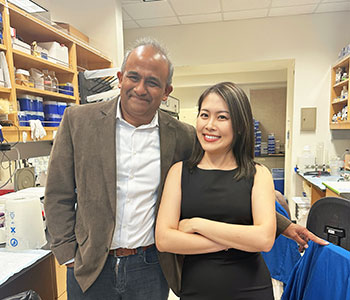Moles can become melanomas through nongenetic transitions, UC Irvine study shows
Discovery of precursor cancer cell types in normal skin could help early detection

Irvine, Calif., June 26, 2025 — Researchers at the University of California, Irvine exploring the genesis of melanoma have identified a cell type in animal and human models that can initiate tumors in the absence of other genetic mutations.
These cells, which resemble neural crest stem cells, were found to be present in human and mouse melanomas, as well as in normal skin, the researchers report in a study published today in the journal Nature Communications. Single-cell transcriptomics and advanced bioinformatics approaches revealed that these cells could act as “precursors of malignant cells,” a finding that has significant implications for developing strategies to detect melanoma early or even prevent melanoma from forming.
“We show that an initial mutation, known to generate either a normal mole or a tumor, need not be followed by a second mutation to change into a melanoma tumor,” said Anand Ganesan, MD, PhD, a UC Irvine professor of dermatology and biological chemistry and corresponding author of the study.
“This opens up the possibility of reverting the tumor cell to back into a normal cell if indeed the event that is causing it is not permanent, like a mutation," added the UCI Health dermatologist and skin cancer specialist. "It also opens up the possibility that one could design a therapy to stop this cellular transition as a way to prevent melanoma.”
Melanoma, which is expected to cause more than 8,000 U.S. deaths in 2025, is a type of cancer that arises in the skin’s pigment-making cells. Called melanocytes, these cells can form a pigmented lesion on the skin called a “mole” and also known as a nevus. Most moles are benign, but those that become melanomas can spread rapidly to other organs throughout the body.
Difficult to diagnose
About 90% of tumors detected early can be cured with surgery, but they can be difficult to diagnose in an initial biopsy. Tracking the transition of the neural crest-like cells could help better identify melanoma in its beginning stages for removal and a cure.
What triggers the change from mole to tumor has been the subject of study for years. Most melanomas are thought to result from exposure to harmful ultraviolet rays. However, other melanomas found in hidden parts of the body not exposed to the sun are difficult to detect let alone prevent.
“Cancer initiation begins with a mutation, but unraveling the sequence and number of mutations required to generate tumors has been challenging,” said Ganesan, a physician-scientist whose previous work has included developing new compounds with the potential to slow the grow of skin cancers. He also serves as co-director for Molecular Diagnostics and Therapeutics at the UCI Health Chao Family Comprehensive Cancer Center.
The research team led by Hui Xiao, PhD, a former graduate student in Ganesan’s lab, conducted In-depth genetic studies of mouse models with mutations of the cell growth-regulating gene BRAF. While the BRAF mutation induced rare melanomas in albino mice, it induced only normal moles in black mice. Notably, consistent mutations were not found in the tumors that arose in albino mice, indicating that additional mutations were not required to generate tumors.
Potential marker for malignancy
“The detection of the cells that can form tumors in biopsies may represent a clinically useful marker of malignant potential as it appears that they are observed in melanomas arising in both mice and humans,” the study said.
“If cancer formation is strictly dependent on the accumulation of genetic mutations, then the only way to prevent cancer would involve preventing the accumulation of additional mutations,” Ganesan added.
“On the other hand, if tumor initiation involves a combination of a mutation and non-genetic events, preventing nongenetic events would be a method to prevent cancer formation. Thus, while wearing sunscreen to prevent mutations is still important in preventing melanomas and other cancers, there may be other therapies we could devise that could prevent normal melanocytes from transitioning into melanoma cells.”
The work required close collaboration between Ganesan and Arthur D. Lander, MD, PhD, an expert in computational biology and the Donald Bren Professor of Developmental Biology, as well as Qing Nie, PhD, an expert in single-cell bioinformatics and the Chancellor’s Professor of Mathematics. The research team also included Jessica Shiu, MD, PhD; Chi-Fen Chen, MS; Jie Wu, PhD; Peijie Zhou, PhD; Sahil S. Telang; Rolando Ruiz-Vega, PhD; and Robert A. Edwards, MD, PhD.
The study was funded by grants from the National Cancer Institute and the National Institute of Arthritis and Musculoskeletal and Skin Diseases.
Anand Ganesan, MD, PhD, a UC Irvine physician-scientist specializing in pigmentary disorders and skin cancer, is the author or co-author of more than 50 peer-reviewed publications. His research focuses on understanding how pigment cells function in the skin; how they give skin its color; how they are lost in vitiligo, and how they can transform into melanoma. His goal is to develop new therapies to treat melanoma and pigmentary disorders. Ganesan serves as co-director for Biotechnology, Imaging and Drug Development and co-director for Molecular Diagnostics and Therapeutics at the UCI Health Chao Family Comprehensive Cancer Center. He is also associate dean for Physician-Scientist Development at the UC Irvine School of Medicine and vice chair for research for the medical school’s Department of Dermatology.
The UCI Health Chao Family Comprehensive Cancer Center is one of only 57 National Cancer Institute-designated U.S. comprehensive cancer centers and the only one based in Orange County, the sixth most populous county in the nation. A research powerhouse, the cancer center brings together basic and translational scientists with clinician investigators to drive discoveries through the pipeline into the clinical arena. The center treats more patients with cancer — and more complex cases — than any other healthcare provider in the region, with more than 80,000 outpatient visits and 65,000 infusion treatments annually at practice sites in Orange, Irvine, Yorba Linda, Newport Beach, Costa Mesa and Laguna Hills. The center also offers more than 500 clinical trials, including the region’s largest portfolio of early-phase and investigator-initiated trials. It has the only adult bone marrow transplant program in Orange County, performing more than 100 transplants a year and enabling critically ill patients to receive life-saving care close to home. It is also one of the few U.S. programs to provide transplants for debilitating autoimmune diseases such as multiple sclerosis. With the opening of its second clinical hub in Irvine in July 2024, the cancer center has tripled its space to treat cancer patients and conduct novel studies aimed at bringing an end to cancer.
UCI Health, one of California’s largest academic health systems, is the clinical enterprise of the University of California, Irvine. The 1,317-bed system comprises its main campus UCI Medical Center, its flagship hospital in Orange, Calif., the UCI Health — Irvine medical campus, four hospitals and affiliated physicians of the UCI Health Community Network in Orange and Los Angeles counties and a network of ambulatory care centers across the region. UCI Medical Center provides tertiary and quaternary care and is home to the only Orange County-based National Cancer Institute-designated comprehensive cancer center, high-risk perinatal/neonatal program and American College of Surgeons-verified Level I adult and Level II pediatric trauma center, gold level 1 geriatric emergency department and regional burn center. Powered by UC Irvine, UCI Health serves nearly 4 million people in Orange County, western Riverside County and southeast Los Angeles County. Follow us on Facebook, Instagram, LinkedIn and X (formerly Twitter).
Find on-demand care at UCI Health using our On Demand Care Finder ›




